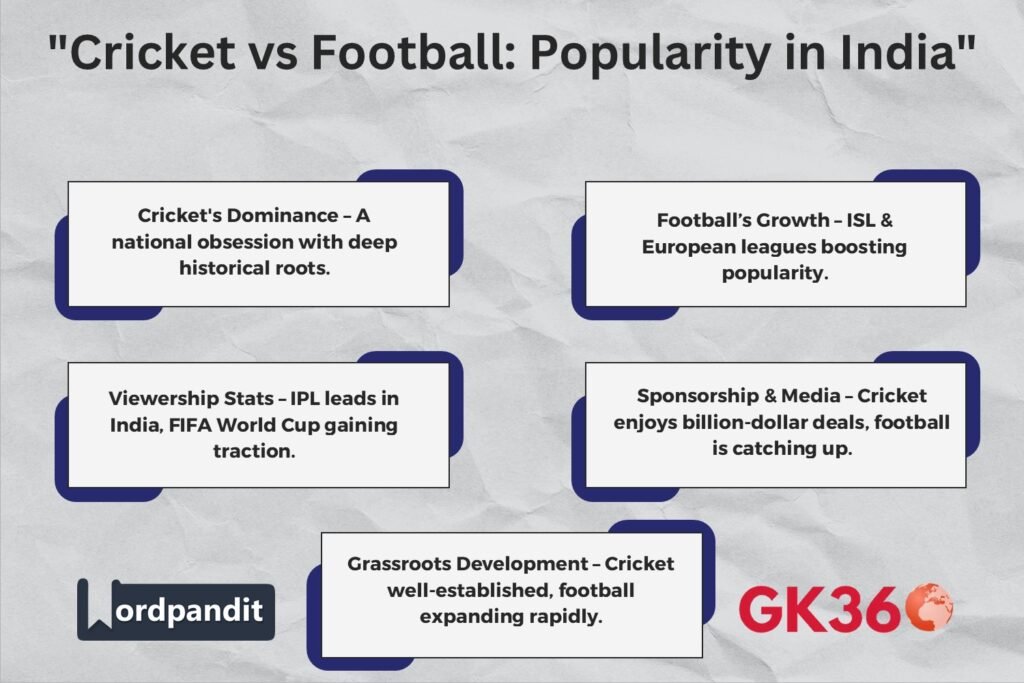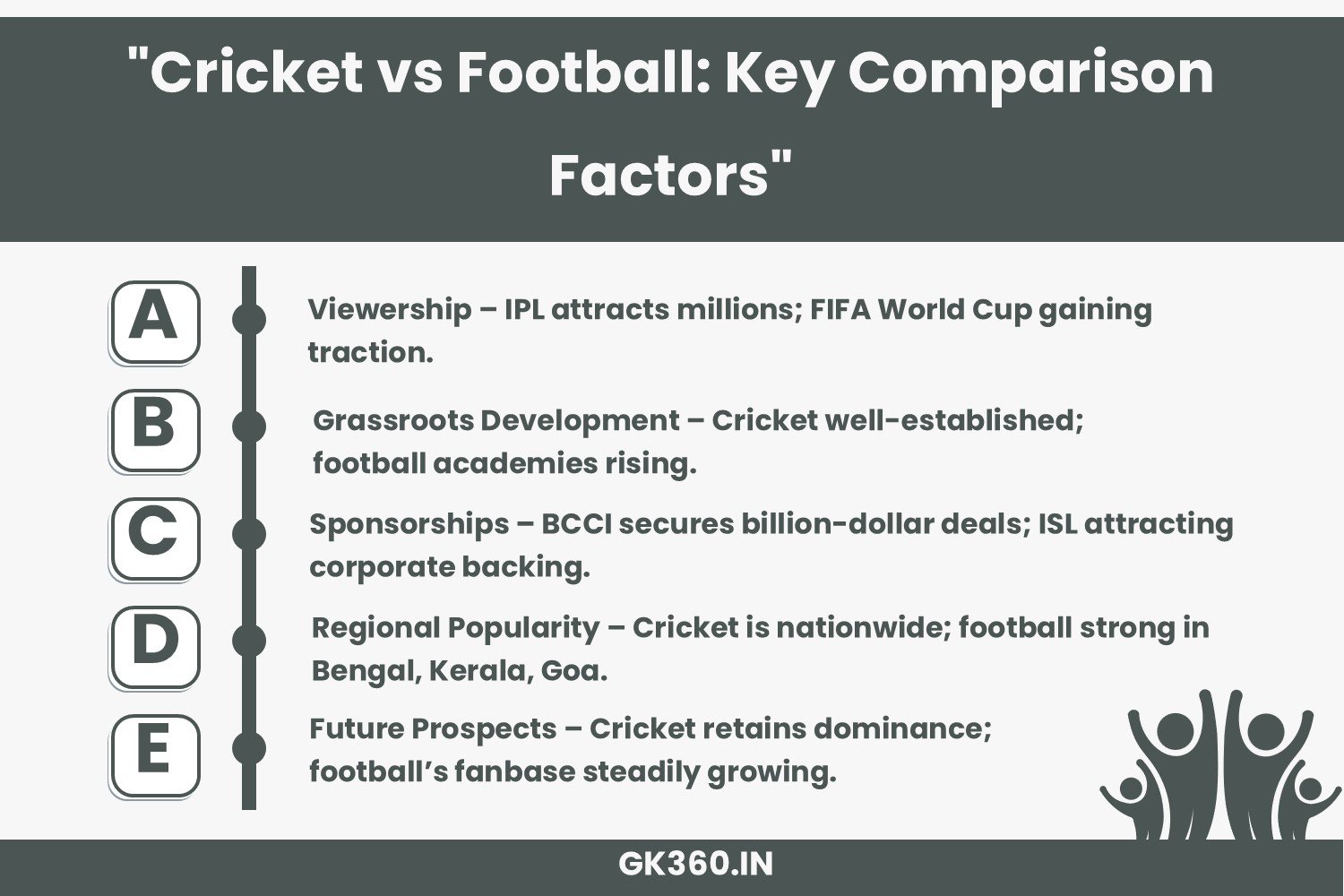Cricket vs Football Popularity in India: A Detailed Comparison
Introduction: The Clash of Titans in Indian Sports Culture
Imagine walking through the bustling streets of any Indian city. On one corner, children passionately discuss a thrilling football match, while on another, heated debates erupt over the latest cricket series. In a country where sports are deeply embedded in culture, cricket and football emerge as the two dominant contenders for public attention.
But which sport truly reigns supreme in India? Is it cricket, often referred to as a religion, or football, a globally celebrated sport steadily gaining traction? This article delves into the heart of the debate, examining their popularity, viewership, grassroots development, and media influence to provide a comprehensive understanding of their standing in India.

Table of Contents
- Cricket: The Undisputed King of Indian Sports
- Football: The Rising Challenger
- Cricket vs Football: A Comparative Analysis
- Real-World Case Studies
- Ethical & Commercial Considerations
- FAQs: Addressing the Key Questions
- Conclusion: The Future of Cricket & Football in India
Cricket: The Undisputed King of Indian Sports
Historical Significance & Cultural Embedment
Cricket’s dominance in India is deeply rooted in history. Introduced during British rule, the sport quickly evolved from an elite pastime to a national obsession. Players like CK Nayudu laid the foundation, and India’s victory in the 1983 Cricket World Cup marked a defining moment, elevating cricket to an unparalleled status.
Cricket’s Reach Across Demographics
One of the key reasons for cricket’s widespread popularity is its accessibility across urban and rural regions. From local school tournaments to casual gully cricket, the sport is played in every corner of the country. Furthermore, the BCCI’s infrastructure investments ensure the systematic development of players at the grassroots level.
IPL’s Role in Boosting Cricket’s Popularity
The Indian Premier League (IPL) revolutionized cricket by blending entertainment with sport. With its star-studded teams, franchise model, and high-intensity T20 format, IPL has become one of the most-watched leagues globally, surpassing several international sports events in terms of viewership.
Viewership & Media Influence
Cricket’s media dominance is evident in:
- Broadcasting Rights: The BCCI is one of the wealthiest sports governing bodies.
- Sponsorship Deals: Major corporations invest billions in cricket-related advertising.
- Social Media Engagement: Indian cricketers rank among the most followed sports personalities worldwide.
Football: The Rising Challenger
Global Appeal & Indian Aspirations
Football is the most-watched sport globally, and India has seen a surge in interest, particularly among the youth. The FIFA World Cup, English Premier League (EPL), La Liga, and UEFA Champions League have created a massive fanbase in India.
The Role of Indian Super League (ISL)
Launched in 2014, the Indian Super League (ISL) aims to replicate IPL’s success. By bringing in international players, improving infrastructure, and boosting local talent, ISL has made significant strides in making football more mainstream in India.
Growing Fanbase & Infrastructure Development
Football has traditionally been popular in states like West Bengal, Kerala, and Goa. However, with the rise of football academies, corporate investments, and grassroots initiatives, the sport is expanding beyond its traditional strongholds.
Media & Viewership Trends
Football’s growth in India is reflected in:
- Increased ISL Viewership: Each season sees higher engagement rates.
- European Leagues Popularity: Social media interactions and streaming subscriptions have surged.
- Brand Sponsorships: Major brands now invest in football clubs, leagues, and grassroots programs.
Cricket vs Football: A Comparative Analysis
| Factor | Cricket | Football |
|---|---|---|
| Viewership | IPL attracts millions per season | FIFA World Cup has growing traction in India |
| Grassroots Development | Well-established cricket academies | Football academies expanding rapidly |
| Media Coverage | Cricket enjoys extensive coverage | Football coverage growing, especially online |
| Sponsorship Deals | BCCI secures billion-dollar deals | ISL attracting corporate backing |
Real-World Case Studies
1983 Cricket World Cup: A Defining Moment
India’s triumph in 1983 was a turning point that led to an exponential rise in cricket’s popularity. This victory united the country and laid the groundwork for future generations of cricketers.
The Rise of ISL: Transforming Indian Football
The ISL has significantly influenced football’s growth in India, increasing youth participation, sponsorships, and global exposure.
Ethical & Commercial Considerations
The Impact of Commercialization on Sports
The IPL model has turned cricket into a multi-billion-dollar industry, but concerns about over-commercialization exist. Similarly, football faces challenges in balancing commercialization and grassroots development.
Regulatory Considerations for Fair Play
Both cricket and football require transparent governance to ensure fair play and prevent corruption.

FAQs: Addressing the Key Questions
- Why is cricket more popular than football in India?
Cricket’s long history, accessibility, and international success have contributed to its dominance. - Can football overtake cricket in India?
With ISL’s growth and global exposure, football has the potential to challenge cricket’s supremacy in the future. - How does ISL compare to IPL in popularity?
While IPL dominates in terms of revenue and viewership, ISL is growing steadily with increased investment and fan engagement. - Which regions in India favor football over cricket?
States like West Bengal, Kerala, Goa, and the Northeast have historically been strongholds for football. - What role does media play in promoting cricket and football?
Media coverage, sponsorships, and digital platforms shape the popularity of both sports.
Conclusion: The Future of Cricket & Football in India
While cricket remains the undisputed leader in Indian sports, football is rapidly gaining ground. With improved infrastructure, growing fan engagement, and increased investment, the future of Indian sports could see a closer competition between the two.
Key Takeaways Table
| Aspect | Cricket | Football |
|---|---|---|
| Viewership | IPL leads with millions of viewers | FIFA, EPL, and ISL viewership growing |
| Grassroots Development | Strong cricket academies & infrastructure | Football academies expanding across India |
| Media Coverage | Extensive TV and digital coverage | Gaining ground with online streaming |
| Sponsorship Deals | Billion-dollar IPL & BCCI deals | ISL & European leagues attracting corporate backing |
| Regional Popularity | Nationwide appeal | Stronghold in Bengal, Kerala, Goa, Northeast |
| Future Potential | Continues to dominate | Rapidly growing with increased investments |
SEO-Driven Tags
- Cricket vs Football Popularity India
- Most Popular Sport in India 2025
- Cricket vs Football Viewership
- ISL vs IPL Popularity
- Indian Football Growth Trends
- BCCI vs AIFF Sponsorships
- Football Fanbase in India
- Future of Indian Sports
- ISL Football Viewership in India
- Cricket and Football Media Coverage





